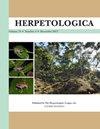Early-Life Dietary Restriction and Diet Type Affect Juvenile Brain Morphology in Spadefoot Toads (Spea bombifrons)
IF 1.3
3区 生物学
Q2 ZOOLOGY
引用次数: 0
Abstract
Abstract: Across a breadth of animal taxa, early-life environmental variation has been demonstrated to have lasting effects on later-life traits, including brain morphology. Here, we use Plains Spadefoot Toads (Spea bombifrons) to evaluate how larval diet type and amount influence later-stage, juvenile brain size and the relative sizes of brain regions. We specifically investigate whether developmental plasticity in brain morphology mirrors previously documented interspecific variation with relation to nutritional restriction and carnivory. Our findings demonstrate, contrary to expectation, that exposure to dietary restriction during the larval stage causes an increase in relative juvenile brain size. However, consistent with our predictions, consuming a prey-based shrimp diet during the larval stage results in relatively larger juvenile telencephalons, an intraspecific response that parallels an interspecific pattern in frogs where more-carnivorous species possess relatively larger telencephalons. Our results demonstrate that early-life dietary restriction and early-life diet type can generate changes in juvenile brain size and morphology in ways that may influence later-life behaviors and fitness. Further, our study suggests that intraspecific and environmentally induced changes in brain morphology can mirror interspecific divergence in brain morphology, supporting a role for developmental plasticity in promoting evolutionary change.生活早期的饮食限制和饮食类型对蟾蜍幼龄大脑形态的影响
摘要:在广泛的动物分类群中,早期生活环境的变化已被证明对后期生活特征(包括大脑形态)有持久的影响。在这里,我们使用Plains Spadefoot蟾蜍(Spea bombiferons)来评估幼虫的饮食类型和数量如何影响后期、幼年期的大脑大小和大脑区域的相对大小。我们专门研究了大脑形态的发育可塑性是否反映了先前记录的与营养限制和肉食性有关的种间变异。我们的研究结果表明,与预期相反,幼虫期暴露于饮食限制会导致相对幼年大脑大小增加。然而,与我们的预测一致,在幼虫期食用以猎物为基础的虾会导致相对较大的幼年端脑,这是一种种种内反应,与蛙类的种间模式相似,在蛙类中,更多的食肉物种拥有相对较大的端脑。我们的研究结果表明,早期饮食限制和早期饮食类型会导致青少年大脑大小和形态的变化,从而影响后期的行为和健康。此外,我们的研究表明,种内和环境诱导的大脑形态变化可以反映大脑形态的种间差异,支持发育可塑性在促进进化变化中的作用。
本文章由计算机程序翻译,如有差异,请以英文原文为准。
求助全文
约1分钟内获得全文
求助全文
来源期刊

Herpetologica
生物-动物学
CiteScore
4.60
自引率
0.00%
发文量
27
审稿时长
>12 weeks
期刊介绍:
Established in 1936, Herpetologica is a quarterly peer-reviewed journal serving herpetologists, biologists, ecologists, conservationists, researchers and the scientific community. The journal contains original research papers and essays about the biology of reptiles and amphibians, and covers many relevant topics including: behavior, conservation, ecology, genetics, morphology, physiology and taxonomy.
 求助内容:
求助内容: 应助结果提醒方式:
应助结果提醒方式:


